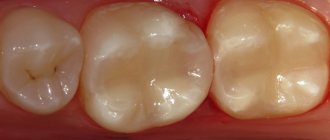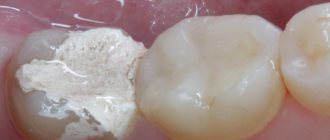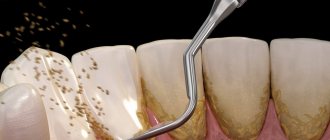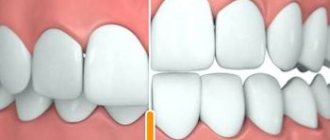How is dental filling performed?
Installing a filling is a standard procedure that takes place under local anesthesia. First, the person is given an injection in the gum to numb the problem area. After this, doctors proceed to treat the incisor, and the process lasts on average 15-20 minutes.
Main stages:
- The doctor prepares the enamel and drills out the softened dentin using a drill. The patient does not feel pain because he was given an injection.
- The oral cavity is disinfected using an antiseptic solution.
- A special paste with a healing effect is installed, and a gasket is placed for insulation.
- The walls of the oral cavity are dried using air flow.
- The mass is applied layer by layer for further filling.
- The filling is polished to obtain the required occlusion. The crowns should fit tightly.
- Fluoride varnish is applied for protection and distributed over the surface of the filling.
The procedure is simple and standard, so dentists perform it quickly. The patient only needs to listen to the doctor’s advice to avoid problems. If the filling is installed efficiently, it will last for more than one year. The specific period depends on the selected material, quality, and food preferences of the person. Filling is one of the most effective methods of combating caries and pulpitis. Moreover, the procedure is inexpensive and has a minimum number of contraindications.
Indications for filling
Filling is one of the methods of restoring the integrity of a tooth. Reasons for treatment:
- stop inflammation in the mouth;
- caries at the initial, middle stages;
- loss of a previously installed filling;
- channel cleaning;
- restore the integrity of the tooth, including after injury;
- prevent the development of complications;
- prevent tooth loss.
In addition, inflammation in the oral cavity and caries are a powerful factor in reducing immunity. Timely treatment will help prevent infection of other organs, since pathogenic flora is often transferred through the bloodstream.
Caries superficial, medium and deep
Filling dental canals
Canal treatment is carried out during deep treatment. The pulp that fills the tooth area is removed, and the walls are cleaned and ground. The process may take a long time, and then the person will have to visit the doctor several times. You will have to install a temporary filling.
The problem area is treated with antibacterial compounds, after which a filling mass is applied. If the procedure is carried out efficiently, then the x-ray will show that the cavity is 100% filled.
The main methods of canal therapy:
- Application of gutta-percha. A standard treatment method that allows you to fill the canals. Hot and cold options are available.
- Depophoresis. The area of the tooth when there are cracks and curvatures is effectively sterilized. The drug is used using a special tool. It can penetrate even into distant areas of the channel.
- Mummification. Impact doses of antiseptic are introduced into the pulp area. The advantage of this option is that the likelihood of inflammation disappears.
- Retrograde filling. A gun with a special attachment is used for it. With its help, you can completely fill the problem cavity.
The dentist will independently choose the appropriate option depending on the situation. The decision is made after an examination, since it is important to determine the condition of the tooth and canal.
What care do fillings require?
Filled teeth do not require any special care, but we must not forget that you need to brush them, regardless of whether they have fillings or not, at least twice a day and very carefully. Dentists also recommend attending professional oral hygiene procedures at least once every six months. In this case, the hygienist should grind existing fillings and pay special attention to them.
You also need to remember that filling material is still more porous than enamel, so it absorbs pigments from coloring foods and drinks more strongly. That is why, immediately after caries treatment, it is not recommended to eat beets, red berries and similar foods for several days, especially when it comes to the front teeth.
Types of fillings
Conventionally, fillings are divided into temporary and permanent. They differ in characteristics and purpose. Temporary ones are placed for therapeutic and diagnostic purposes. Often the composition of the material contains medicinal additives that are necessary for the treatment of a specific disease. The filling will last a short period of time - from 7 days to a month. Much depends on the situation, but in any case you will have to contact a medical specialist again soon.
The integrity of a temporary filling cannot be maintained for more than two weeks. For this reason, you should not put off visiting the dentist until later if you want to avoid problems.
The temporary variety is used in certain situations. A noticeable carious lesion may be observed, but it may not be clear whether only the enamel is affected or whether the lesion has reached the pulp. The doctor will want to examine the incisor in more detail to make an accurate conclusion and perform the correct treatment. The dentist will perform a temporary filling and then monitor the person. If the pain persists, then pulpitis can be suspected. In such a situation, you will have to remove the neurovascular bundle, perform root canal therapy and fill the cavity.
There are several types of permanent fillings. This type is generally intended for long-term and reliable sealing of the treated tooth. It is important to preserve the original characteristics of the incisor, that is, the chewing function should not be impaired. If the tooth is in the anterior region, then it is important to preserve the natural color and shape. In this case, it will not be noticeable that the person did the filling.
Types of fillings depending on the material:
- Cement. It is durable, lasts a long time and meets all requirements. It is important to understand that the density of a cement filling is higher than that of enamel. For this reason, the area that surrounds the filling gradually wears out. As a result, the marginal zone becomes vulnerable, which can lead to secondary caries.
- Amalgam. This variety has many disadvantages. For this reason, this option is extremely rarely used. The composition contains mercury, zinc, copper and silver. The material is durable and does not wear out for a long time. Disadvantages include toxic effects, poor aesthetics and low levels of adhesion.
- Plastic. Now this option is not used, since the material is toxic, has a high probability of deformation, and is easily washed and stained. There is a significant chance of encountering a complication - a secondary form of caries.
- Ceramics. The material is expensive, but of high quality. The filling can last from 20 to 25 years. Ceramics are excellent for filling; their appearance is close to natural teeth. It is durable, resistant to temperature fluctuations, and retains its original shade. Expensive, but the highest quality material.
- Light polymer. The material is considered in demand because it is inexpensive, resembles real teeth in appearance, and has optimal technical performance. The light filling hardens under the influence of an ultraviolet lamp. The dentist may spend a long time shaping the tooth until it achieves the desired appearance. Average service life is 5 years. During this period, the aesthetic appearance is maintained.
- Composite It contains porcelain, which makes the fillings durable and hard. The service life reaches 10-15 years. Among the disadvantages, polymerization shrinkage can be noted. It can be prevented by using additional adhesives that will prevent the occurrence of secondary caries.
It is difficult to say unequivocally which material is best suited in a particular situation. It all depends on the person’s personal wishes, financial capabilities and tooth condition. It is recommended to choose only high-quality materials that will last a long time.
Light-curing filling: advantages and installation features
A more accurate name for this dental composite material is photopolymer filling. The prefix “photo-” indicates that special light is needed to cure the filling, and polymers are composite materials.
A light filling gives the dentist the opportunity to accurately reproduce a full-fledged tooth, because, unlike a cement filling, it hardens only under the influence of a lamp. However, it is worth remembering that over time, even the best light-curing filling will darken or become noticeable at the border with the enamel. Therefore, and also because it may fall out at the end of its service life, the structure requires timely replacement, on average, once every five years. As for installing fillings on the front teeth, modern dentistry suggests using ceramic inlays instead. They are better, imitate natural tissues, last longer and are practically invisible on the teeth even after several years.
Filling teeth without pain
Nowadays people do not need to be afraid of visiting the dentist, because dental treatment is carried out without pain. High-quality anesthesia is used, and an allergy test is performed first. If the body accepts the drug normally, then the dose is administered in the gum area. After 1-2 minutes the effect appears. A person may notice that the problem area has lost sensation. After this, the doctor can proceed to the procedure itself.
When using anesthesia, a person will not feel pain. You will be able to relax in the dental chair and not worry about anything. This treatment option is the most preferable, because not every patient wants to endure pain.
Some people decide not to use anesthesia. This is because they do not want to administer the medicine or are suffering from an allergic reaction. If the nerve is not affected, the procedure will cause virtually no pain. An experienced specialist will do everything to make the patient feel as comfortable as possible.
Is it possible to place a filling without using an anesthetic?
It is, in principle, possible to place a filling on a tooth without the use of anesthesia, but only if we are talking about the treatment of non-advanced and shallow caries. If the tooth damage is significant, it is better not to refuse anesthesia!
Do not worry that the use of anesthetics may cause any harm to your health: the type of drugs and their dosage are selected individually for each patient. Using local anesthesia will allow you to place a filling on your tooth without pain, stress or discomfort!
How much should you not eat after filling a tooth?
Filling is considered a simple procedure, after which a person immediately returns to his normal lifestyle. At the same time, dentists warn that it is undesirable to eat and drink drinks right away. It is advisable to abstain from food for 2-3 hours. During this time, the filling will take root, so the food will not be harmful in the future.
It is recommended not to drink coffee or strong tea for 24 hours to avoid staining the material. If the procedure is carried out well, the person will not encounter any problems, and will therefore be able to fully chew with the repaired tooth.
Temporary filling and permanent filling - what is the difference?
The dentist places a permanent filling in the tooth cavity left after caries has been removed. It is needed to cover sensitive tooth tissues and prevent saliva and food debris, as well as bacteria and microbes, from getting inside. In addition, with its help, the dentist-therapist restores that part of the tooth that had to be removed during treatment. This is necessary not only from an aesthetic point of view, but also because a missing tooth will not be able to fully participate in closing the jaws, and this can lead to malocclusion. Therefore, it is so important for the doctor to properly sharpen and polish the filling, because its average service life is about five years.
Temporary filling, as its name implies, is carried out for a short period of time, usually no more than two weeks. It is also necessary when dental treatment takes place in several stages, which means several visits. This happens when it is necessary to put medicine into the dental canals for several days, or when the treatment is so long that the patient cannot sit in a chair for so long at one time, or when, instead of a permanent filling, the dentist plans to install a ceramic dental tooth for the patient. inlay, and its production takes place in a dental laboratory using impressions of the processed tooth and takes from one to several days. In such cases, a temporary filling helps; it is cheaper than a permanent one, is installed faster and is easily removed when it is no longer needed. But at the same time, it also protects the drilled cavity from saliva, food debris and bacteria.
Contraindications
In rare cases, filling leads to complications. A person experiences pain even after 3 days from the date of the intervention. Unpleasant sensations can be sharp and shooting, they cannot be eliminated with the help of analgesics. This happens when there is inflammation of adjacent tissues, incomplete removal of the nerve, or poor material. More often, complications are encountered by those people who did not take into account contraindications. In some cases, the procedure cannot be performed, as it can only worsen the situation.
Main contraindications:
- The tooth cannot be restored, so it will have to be removed.
- An x-ray revealed internal root resorption.
- There is severe resorption, which affects more than a third of the root.
- There are carious perforations in the bottom of the chamber.
- Bone loss in which there is loss of periodontal attachment.
- There is a follicular or odontogenic cyst.
The doctor will tell the person whether there are contraindications for the procedure.
Canal treatment methods
The doctor’s task in the treatment of pulpitis and periostitis is to relieve the source of inflammation, suppress the bacterial flora, and clean the canals. And after that, installation of the seal.
Canal treatment methods:
- Therapeutic – used in the early stages of the disease. The dentist will administer the medication, install a gasket, and a temporary filling. After the inflammatory process subsides, it becomes permanent.
- Surgical – removal of the pulp, all affected tissues, cleaning and disinfection of all tooth cavities. After stopping the inflammatory process, the doctor fills the resulting cavities with specialized gutta-percha. Previously, arsenic was used to remove pulp, but this method is no longer used.
Endodontic treatment is sometimes indicated. For example, with abscesses, phlegmons, cysts or granulomas in the root area.
Filling services in our clinic
Our clinic in the center of Moscow offers high-quality dental filling services. Experienced dentists with extensive experience approach each client individually and do everything to ensure that the procedure is comfortable. Doctors will choose the type of filling needed after examining the oral cavity. Only high-quality and modern materials are used, which have a long service life.
We perform root fillings without pain or any discomfort. If necessary, we will restore the primary incisors so that they do not further deteriorate and fall out prematurely.
Dentists guarantee a high-quality result - the filling will not differ in appearance from the tooth. It will last for a maximum period, which is determined by the selected material. There are both budget options and expensive ones. The client will be able to choose a specific filling service based on personal needs.
What are the complications after installing a filling?
The most common complaint from patients after visiting the dentist is a feeling as if the tooth under the filling hurts. Such sensations are absolutely normal for several hours after treatment (up to 1 day), but if the pain does not subside the next day, this may mean that the doctor made a mistake, for example, did not properly treat the carious cavity before installing a filling. If a day has passed and the tooth still hurts, you need to go to the dentist again, you may have to take an x-ray and, if necessary, re-treat.
Another common reason for visiting a dentist is when a filling has fallen out. As we have already said, these structures have a certain service life, after which they need to be replaced; if this is not done, they can actually fall out. And in such situations, the main thing is to understand why this happened - because the tooth was not treated for a long time, or did secondary caries develop in it? As for fresh fillings, they can only fall out in the event of a medical error. Therefore, choose proven clinics where quality fillings are installed in Moscow.
Is it possible to restore a tooth again?
Today, there are frequent calls from patients whose teeth are destroyed, treated 7-10 or more years ago. Back then, old technologies were used, the materials had expired, and the tooth needed to be restored again.
Many people just want to grind down the tooth and put a crown on it. During the consultation, we consider all methods. If the tooth has been filled and there is a chip in the filling or wall, then by eliminating the defect, this is possible. But, when complex restoration has already been carried out, especially on the frontal units, canines, replacement of old structures is necessary.
If the tooth was strengthened with a metal pin, and the wall was built up with a composite material, which darkened over time and began to crack, then drastic intervention will be required. First, you need to free the tooth from used materials: remove the filling, remove the pin. If necessary, treat incipient caries (often the patient himself does not know about the developing process).
The best way out
– this is the installation of inlays or solid modules, crown plus tooth root, using Cerec.
The scanner will “notice” all the structural features of the tooth; the program takes into account not only the features of the unit, but also all the nuances of the bite. How long does it take to make such crowns or complete modules for teeth? Only 1.5 hours
, small temporary deviations are possible.
The new tooth will look natural. During the consultation, we will decide how to restore the unit, what kind of crown is needed for the tooth, and choose the technology. At my appointment, you will feel calm, absolutely not afraid. Believe me, I will find a way to save a tooth even in the most difficult cases.
How the procedure works
For uncomplicated caries, filling is carried out after removing pathologically changed areas of the tooth, cleaning and treating the resulting cavity. Photopolymer fillings harden under the influence of light radiation.
In case of pulpitis, the doctor, after treating and cleaning the canal, fills it with plastic material - gutta-percha - this is a special rubber that hermetically fills the canals of the tooth. First, the doctor may place a temporary filling for a couple of weeks, or sometimes even a month, to make sure that the treatment was successful.
Treatment of caries using filling is carried out in one visit. With superficial and medium caries, there is practically no pain. In the case of its deep form, there is a need for local anesthesia. The key to success in such treatment will be a well-prepared, absolutely clean and dry tooth surface. And as a result, the service life of the filling will be as long as possible.











